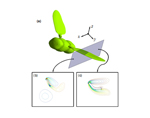
Topics
Multiscale modeling of intracranial aneurysms

Aneurysmal recanalization and coil compaction after coil embolization of intracranial aneurysms is seen in as many as 40% of clinical cases. The aim of the project is the development of novel, multiscale modeling strategies that will facilitate a better understanding of the complex interactions between detachable coils and the local blood flow in intracranial aneurysms.
Collaborators: B.B. Liebber
Insect flight biomechanics

Flapping flight is known to be the single most successful mode of animal locomotion in thousands of species of birds and insects. Several studies over the past decades reviled some unique mechanisms that enable the generation of unsteady aerodynamic forces during hovering and maneuvering. The question the present study wants to address is the following: “How does structural flexibility affect the aerodynamic performance of flapping wing?” For this purpose we will conduct large-scale computations of complex fluid-structure interaction problems that result from the unsteady, nonlinear aerodynamics of flapping flight. The large eddy simulation (LES) approach is combined with detailed structural models (whose degrees of freedom and geometries will be informed by kinematic data collected from the experimental studies) to simulate the evolution of moving, elastic lifting surfaces together with their surrounding fluid.
Collaborators: B.Balachandran
Large-Eddy Simulation of Turbulent Flows with Dynamically Moving Boundaries

A common feature in most biological flows is the presence of moving/deforming boundaries. The focus of this project is the development of tools and methods applicable to fluid-structure interactions in the framework of Direct Numerical Simulations (DNS) and large-eddy simulation (LES). Numerical simulations of turbulent flows interacting with dynamically moving boundaries are amongst the most challenging problems in computational mechanic. The tools we have been working on are based non-boundary conforming approaches where the interface between the fluid and the structure is sharply defined, and fluid-structure interactions involving multiple bodies can be treated in a straightforward manner. Adaptive mesh refinement (AMR) are also being developed to improve cost-efficiency.
Why golfballs have dimples?

High performance computing can be used to address important problems related to science and engineering but also for fun. We have used our parallel Navier-Stokes solver to compute the flow around a golf ball traveling at speeds up to 100mph. The computations are amongst the largest Direct Numerical Simulations of complex flows ever performed, involving billions of grid points and thousands of processors on large parallel clusters. Our aim is to illuminate the detailed mechanisms by which the dimples dramatically reduce the drag force on the golf ball over a narrow range of speeds.
Collaborators: K. Squiers, M. Tsunoda
Turbulence in the cardiovascular circulation
Turbulence is an exception and not the rule in normal blood circulation. There are several pathological situations, however, where disturbed flow patterns are present. A characteristic example is the circulation of blood inside diseased arteries with various degrees of atherosclerosis. In such cases, the deposition of plaque on the walls reduces the vessel diameter, creating a constriction (or stenoses) that significantly alters the local blood flow dynamics. Flows, which were initially laminar, can locally transition to a disturbed or quasi-turbulent state, depending on the geometry, forcing conditions and fluid properties. From a biological point-of-view, the changes that take place in the flow have a profound effect on the structure and function of the arterial wall and the development of the disease. The Direct Numerical Simulations performed in this study are in excellent agreement with past experimental observations and provide, for the first time, a comprehensive picture on the detailed turbulent kinetic energy production, dissipation and transport mechanisms downstream of the constriction.
The fluid mechanics of mayfly naiads
 Figure 1: Ephemeroptera. Baetidae: Callibaetis ferrugineus Nymph; photo by Mike Higgins. Part of NABS Macroinvertebrates slide collection (www.benthos.org).
Figure 1: Ephemeroptera. Baetidae: Callibaetis ferrugineus Nymph; photo by Mike Higgins. Part of NABS Macroinvertebrates slide collection (www.benthos.org).Mayflies are a diverse order of aquatic insect that spends the majority of its life as an underwater nymph. A distinctive feature of the mayfly naiad that has helped this order proliferate over vast range of environmental conditions is the presence of 7 pairs of gill plates on the lateral dorsal region of the abdomen. In many species, these plates actively beat in a metachronal fashion to produce an external current that aids in the circulation of fresh oxygenated water. This has allowed mayflies to tolerate poorly oxygenated waters and dominate an environmental niche that would have otherwise been unavailable to them. From an applied engineering perspective, understanding the microcirculation dynamics of mayfly nymphs can help improve future generations of distributed and autonomous chemical sensor networks, which often require an external convective current to achieve rapid and reliable performance. The present project combines measurements and computations to get in depth understanding of viscous and inertial dominated pumping mechanisms that mayflies use.
Collaborators: K. Kiger
